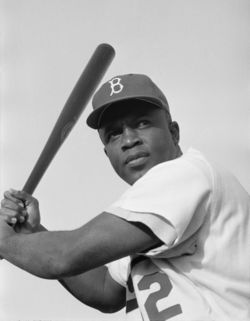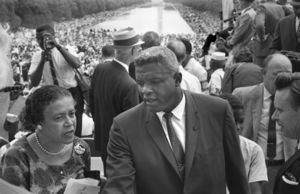When Did Jackie Robinson Integrate Baseball and Why Is It Important
Jackie Robinson was the first African-American to play in major league baseball on April 15, 1947. He went 0 for 3. He reached base once, scoring a run in a Brooklyn Dodgers victory. As a statistical line it was not the most auspicious of debuts. That Robinson debuted at all was the greatest accomplishment of the day.
In 1947, The United States was still legally segregated throughout the south and tradition and custom segregated much of the rest of the country. The armed forces were still segregated by race and the national pastime, baseball, was as well. The idea that any of these laws, customs or institutions would change was almost impossible to fathom. Yet, Jackie Robinson would not only integrate baseball that spring, but by the fall of 1947 he would play in the World Series and was named the Rookie of the Year for the season. As great as Robinson’s first season was, his debut was years in the making and would have ramifications well beyond 1947.
Early Years
Jack Roosevelt Robinson was born in 1919 in Cairo, Georgia. He was the son of a sharecropper and grandson of a slave. The status of African-Americans in the south hadn’t changed a great deal since slavery. There was freedom, but the right to vote was almost completely denied to to African-Americans. The court case that made “separate but equal” the law of the land was decided almost twenty-five years prior and was firmly entrenched in the state of Georgia.
The Robinson family was poor, and poorer still when Jackie’s father left in 1920. His mother moved Jackie and his 5 brothers and sisters to Pasadena, California in hopes of finding a better life. Jackie proved to be adroit in the classroom as well as the athletic field. In order to stay close to his family he matriculated into Pasadena Junior College. After his two years there, he accepted a scholarship to the University of California, Los Angeles (UCLA). Robinson was a star in many sports, including track, football, basketball and baseball.
Robinson left UCLA shortly before his graduation because of financial difficulties. He took on numerous jobs, including putting his football skills to use in a semi-professional league. His first stint as a professional athlete was short-lived. After the Japanese attacked Pearl Harbor, and the US entry into World War Two, Robinson was drafted into the army in 1942. Like the rest of society, the army was also segregated by race. An episode in Robinson’s military career foreshadowed his later role in civil rights. Robinson and some fellow African-American soldiers applied to Officer Candidate School(OCS). Like baseball, the Army didn’t formally exclude African-Americans from OCS. After a protest campaign that included Joe Louis and Truman Gibson (a member of Franklin Roosevelt’s “Black Cabinet”) Robinson and his comrades were accepted. Robinson was commissioned as a second lieutenant in 1943.
Even as an officer, Robinson faced discrimination in the army. In 1944, while stationed in Texas, he refused to move to the back of a bus for a white passenger. He was brought before a court martial for insubordination. Eventually he was acquitted of all charges and later that year he was given an honorable discharge from the army.
Getting the Call
After leaving the army, Robinson looked for work, especially where he could maximize his athletic talents. In 1945 he played for the Kansas City Monarchs, one of the most successful clubs in the Negro Leagues. He was a good player on a team full of great players. The idea of integrating the Major Leagues was picking up steam after the first commissioner of baseball, Kenesaw Landis, died in 1944. One executive in particular was determined to bring African-Americans into baseball, Branch Rickey of the Brooklyn Dodgers. Rickey wasn’t just looking for the best player on the field, but for an individual who could handle the pressure and resistance that would come with being the first African-American to cross the color line.
Robinson was on Rickey’s radar even before he officially scouted him. His background of restrained protest, allowing demonstrations and the court to determine his fate in the Army, appealed to Rickey. In addition to being an Army officer, Rickey was drawn to Robinson because of his collegiate success. Robinson was an educated, talented and determined young man who had demonstrated resolve in volatile situations. He was the type of man that Rickey believed would be successful if given the chance.
Rickey started the process by offering Robinson a spot in the Brooklyn Dodger minor league system. Due to his ability and the rigor of the Negro Leagues, Robinson started at the highest minor league affiliate of the Dodgers, the Montreal Royals. In addition, having Robinson in Canada and playing in a league who’s southernmost team was in Baltimore relieved some of the racial tension that Robinson would have faced playing elsewhere in the minor league system. Robison led the Royals and won the league batting title as part of a championship campaign in the International League. There was no where for Robinson to go but up.
First Season
Rumors swirled during the spring training of 1947. The Brooklyn Dodgers were going to promote their talented minor league star Jackie Robinson to the major leagues perhaps to start the season, perhaps later in the year. The white players in the league and on his own team were divided on whether or not they would share the field with a black man. Two days before the season was about to begin, Many Dodgers planned to boycott the game and not take the field with Robinson. Branch Rickey and the Brooklyn management stood behind Robinson and their decision to play him and the players backed down.
After that first game without a hit, Robinson settled into the season, batting .300 for most of the campaign and leading the team in home runs, stolen bases and total bases. The Dodgers took the New York Yankees to a game seven in the 1947 World Series, ultimately losing the championship 4 games to 3.

Robinson’s debut had an almost immediate impact throughout baseball. In July of 1947 Larry Doby became the first African-American to play for an American League team, the Cleveland Indians. Others followed in 1947, Willard Brown and Henry Thompson were briefly called up for the St. Louis Browns. Dan Bankhead pitched in three games for the Brooklyn Dodgers in 1947 as well. Though Robinson and Doby were the only two to stay for an extended period of time from that 1947 class, it was clear that the color line was a thing of the past.
The color line was receding to history, but racial intolerance and discrimination were not. During that 1947 season, Robinson and those that followed faced countless encounters both on the field and from the stands. Verbal abuse was common, physical threats and actual violence as well. The Dodgers and Robinson received hate mail, threatening Robinson if he played at a visiting field. Through it all, Robinson maintained his composure and grace.
Legacy
Robinson played professional baseball for ten seasons. When the Dodgers traded him to the New York Giants in the fall of 1956, he refused to report to the new team, effectively ending his career. At the time of his retirement, 13 of the 16 major league teams had integrated their squads. In the first wave of African-American players to reach the major leagues, six were later elected to the Hall of Fame, including Monte Irvin, Ernie Banks and Willie Mays. Robison was elected to the baseball Hall of Fame in 1962, his first year of eligibility. He had his number 42 retired by the Dodgers in 1972. To honor his legacy for all of baseball, Major League Baseball retired his number for all teams in 1997, the only player to be afforded such an honor.
Robinson and the integration of baseball was pioneering, not only in sports, but in society as well. Robinson’s first game predated the integration of the armed forces (1948) Brown v. Board of Education (1954, the Supreme Court decision to end segregation in public education) and the Montgomery Bus Boycott (1955) which many mark as the beginning of the modern civil rights movement.
It is telling that every team wouldn’t become integrated until 1959, a dozen seasons after Robinson debuted in 1947. Progress might have been achieved, but it was slow and halting. After his retirement Robinson dedicated much of his time toward the goals of civil rights. Though he had a business and broadcast career, Robinson was a constantly involved throughout the 1950s and 1960s. He was an active member of the National Association for the Advancement of Colored People (NAACP) including serving on the board of directors until 1967. He spoke to the Southern Christian Leadership Council in 1962 and was in attendance at the 1963 March on Washington.
Robinson was also active in mainstream politics as well, always supporting the candidate he felt best advanced the cause of civil rights. He supported Richard Nixon in 1960, but felt Kennedy during his presidency was a strong advocate for African-Americans. When the Republican Party nominated Barry Goldwater in 1964, he left the party entirely and supported the Democrats for the rest of his life. Sadly, it was only a short time. Due to complications from diabetes and heart disease, Robinson suffered heart attack in 1974 and died. He was 53 years old.
Jackie Robinson is remembered for that day in April 1947, but for so much more as well. Not only was the first African-American to play Major League baseball, he did it under extraordinary circumstances. He experienced the full force of American racism both on and off the field. He stood up to that racism during his playing career and well beyond. Jackie Robinson’s fight against discrimination and inequality didn’t end with his Major League debut, it had barely started. His stellar career and continued activism afterward are what make him a hero.
Suggested Readings
Robert Cottrell, Two Pioneers: How Hank Greenberg and Jackie Robinson Transformed Baseball — and America, Potomac Books, 2012.
Chris Lamb, Conspiracy of Silence: Sportswriters and the Long Campaign to Desegregate Baseball, University of Nebraska Press, 2012.
Arnold Rampersad, Jackie Robinson: A Biography, Ballantine Books, 1998.
Bibliography
Tygiel, J. (1983). Baseball's great experiment: Jackie Robinson and his legacy, New York: Oxford University Press.
Peterson, R. (1970) Only the Ball was White: A History of Legendary Black Players and All-Black Professional Teams, New York, Oxford University Press.
Gurevitz, A. E. (2015). "Breaking Baseball’s Color Line." Arizona Journal of Interdisciplinary Studies Volume 4, 86-101.

